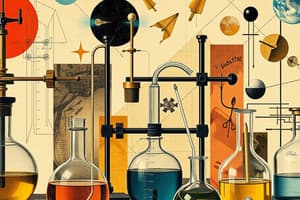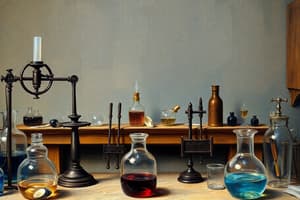Podcast
Questions and Answers
Match the following laboratory equipment with their primary usage:
Match the following laboratory equipment with their primary usage:
Tongs = Used for holding hot objects like test tube and beaker Test Tube Racks = Used for stirring solutions and suspensions Stirring Rod = Used for holding test tubes Mortar and Pestle = Used to prepare ingredients or substances by crushing and grinding them
Match the following measuring devices with their intended measurement:
Match the following measuring devices with their intended measurement:
Thermometer = Used to measure temperature pH Meter = Used to measure the acidity or basicity of a solution Ammeter = Used to measure the amount of current flowing Weighting Scale = Used to hold test tubes
Match the following personal protective equipment with their function:
Match the following personal protective equipment with their function:
Gloves = It protects your hand when handling hot materials Safety Goggles = Protects your eyes from chemical splashes Lab Coat = It protects the skin from chemical splashes Wire Brush = Used for cleaning equipment
Match the following types of paper to their specific uses:
Match the following types of paper to their specific uses:
Match the following equipment with their primary function in the laboratory:
Match the following equipment with their primary function in the laboratory:
Match the laboratory apparatus with their primary uses:
Match the laboratory apparatus with their primary uses:
Match the laboratory apparatus with their primary uses:
Match the laboratory apparatus with their primary uses:
Match the laboratory apparatus with their primary uses:
Match the laboratory apparatus with their primary uses:
Match the laboratory apparatus with their primary uses:
Match the laboratory apparatus with their primary uses:
Match the laboratory apparatus with their primary uses:
Match the laboratory apparatus with their primary uses:
Match the laboratory apparatus with their primary uses:
Match the laboratory apparatus with their primary uses:
Match the laboratory apparatus with their primary uses:
Match the laboratory apparatus with their primary uses:
Match the laboratory apparatus with their primary uses:
Match the laboratory apparatus with their primary uses:
Flashcards are hidden until you start studying
Study Notes
Laboratory Apparatus and Their Uses
- Beaker: Ideal for measuring and transporting liquids; often used for mixing solutions.
- Erlenmeyer Flask: Designed for holding, mixing, and heating chemicals; features a narrow neck to reduce evaporation.
- Test Tube: Commonly used for collecting and storing samples, especially bodily fluids like blood; allows for easy mixing and heating.
- Graduated Cylinder: Provides precise measurement of liquid volumes with multiple graduation marks; more accurate than beakers and flasks.
- Pipette: Essential for measuring and transferring small volumes of liquids, usually in milliliters or microliters.
- Volumetric Flask: Used for accurate measurement of specific liquid volumes; ideal for preparing standard solutions.
- Petri Dish: A shallow, flat dish used to culture microorganisms for biological studies.
- Microscope Slide: Holds samples for observation under a microscope; vital for viewing small specimens.
- Cover Slip: Covers samples on microscope slides to protect them and prevent contamination.
- Microscope: Magnifies small objects and organisms, allowing for detailed observation and study.
- Centrifuge: Separates components of mixtures using centrifugal force; essential for separating liquids of different densities.
- Hot Plate: Equipped with a flat surface for heating materials; commonly used for temperature-controlled experiments.
- Bunsen Burner: Provides a rapid and intense heat source; used for sterilization and heating substances.
- Tripod Stand: Supports laboratory equipment like beakers and flasks above heat sources, ensuring stability during heating.
- Wire Gauze: Placed above the tripod to evenly distribute heat to the bottom of flasks or beakers.
- Tongs: Used for safely holding and manipulating hot apparatus such as test tubes and beakers.
- Separatory Funnel: Designed to separate two immiscible liquids, such as oil and water, through controlled pouring.
- Rubber Tubing: A flexible hose used for transporting liquids and gases; essential in various setups.
- Mortar and Pestle: Implements for grinding and crushing substances to prepare powders or mixtures.
- Test Tube Racks: Organizes and holds test tubes securely in place to prevent spills and breakage.
- Stirring Rod: Used to mix solutions thoroughly, promoting homogeneity in liquid mixtures.
- Thermometer: Measures temperature, critical for experiments requiring temperature control.
- pH Meter: Accurately assesses the acidity or basicity of a solution, crucial for chemical analysis.
- Gloves: Protect hands from heat and hazardous materials during lab work.
- Safety Goggles: Shields eyes from chemical splashes and other potential hazards; essential for safety.
- Lab Coat: Provides protection for skin against chemical splashes and spills during experiments.
- Wire Brush: Utilized for cleaning laboratory equipment ensuring maintenance and hygiene.
- Weighing Scale: Measures weight of materials, necessary for precise formulations in experiments.
- Litmus Paper: Indicates pH levels of solutions through color changes, a quick method for pH testing.
- Ammeter: Measures the current flow in electrical circuits, crucial for experiments involving electricity.
Studying That Suits You
Use AI to generate personalized quizzes and flashcards to suit your learning preferences.




